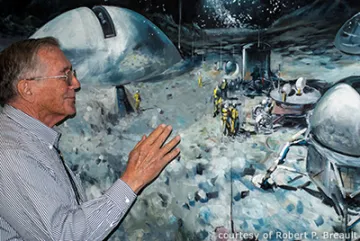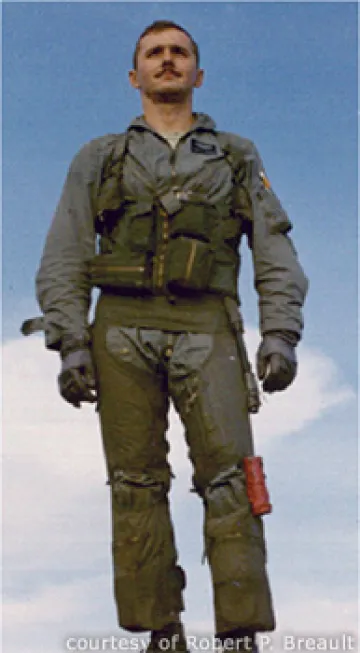Etendue: Robert P. Breault
Welcome to Etendue, featuring interesting and accomplished individuals known for their leadership and contributions both with their careers and the College of Optical Sciences, in their own words. (For a similar view on the college’s best and brightest – our students – please check out Another Wavelength among our Students in the Spotlight.)
This week, we hear from Robert P. Breault, Ph.D. 1979.

Where are you from?
I come from the small rural industrial town of Naugatuck, Connecticut. I was born on March 2, 1941, the third child in a family of four children. Like my two older sisters, I was born at home. I recall my childhood as a wonderful lower-middle-income loving family. Both of my parents worked in a footwear manufacturing plant, a real sweatshop of the day. When in college, I too worked there on the night shift from 10 p.m. until 6 a.m. Once, three nights in a row, the glass thermometers I brought in broke because the inside temperature exceeded 120 degrees.
I was very much a kid scientist. I walked the woods in Connecticut and I collected a vast array of crystalline rock material, my first exposure to optics. I studied and read college texts about the molecular structure and why they formed crystals in the shape they did.
I came from an era when 10-to-17-year-old kids would experimentally build their own solid-state rockets, including various mixtures of fuel. Yes, the fuel engines I made did explode and the shrapnel would go over multiple houses. I would launch my rockets relatively close to the center of town and they would fly over multiple churches and rows of houses. I always found them. They never caused any damage.
Who or what influenced your interest in optics?
When I was 14 I read Frontiers of Astronomy by Fred Hoyle, and that had the most profound effect on my life. I just loved what astronomers could learn from light. Shortly after reading it, on a Saturday morning, I meditated deeply and made what was to be my lifetime decision. I wrote down a plan to go to college. At that time only about 20 percent of my peers went to college. No one in my family ever had. My dad was from Canada and he never graduated from grammar school. My mother did not go to high school and took a job at age 16 (illegally) at S.S. Kresge Company (now Kmart) to help support her family. My family did not travel but to Rhode Island and Massachusetts.

Nevertheless, my plans were to obtain an undergraduate degree in mathematics; become a U.S. Air Force fighter pilot; go to Luke Air Force Base (fighter school training), then Edwards Air Force Base (test pilot) and finally Nellis Air Force Base, the Air Force’s "Top Gun" school, as an instructor; and earn a Ph.D. in astronomy at age 36 from the University of Arizona to do space-based research as a pilot-astronaut or as a space-based research scientist. Recall that this was three years before Sputnik.
On Friday, Aug. 19, 1955, my plans had a serious setback. I was awakened by my mom and dad at about 6 a.m. They had been sent home from work because of an impending flood from the rain of Hurricane Diane. My siblings and I excitedly went across the street to the railroad station and watched for about three hours as 70-foot trees and railroad boxcars and parts of houses floated down the river. It was thrilling. About 9 a.m., my mother told us to come home; we had to evacuate our house. Forty minutes after we left, our home was underwater up to the ceiling of the first floor. It was the first 100-year flood. We lost everything but the clothes we wore. We lived with friends for two months and I had to go to the Red Cross for clothes and food. I said it was the first 100-year flood because by Oct. 15 of the same year, after we had rebuilt our very flood-damaged house, and the day that my eldest sister got married, there was a second 100-year flood. This time it did not breach the levy, but by just four inches.
Describe your career.
I never did make Edwards Air Force Base but I did all the rest, save for getting my Ph.D. in optics at age 38 instead of astronomy at age 36. Upon graduation with my Ph.D. in 1979 I received, unsolicited, an application for the astronaut program, which I chose not to submit, because I had chosen to start the Breault Research Organization Inc. instead.
I am very happy that I created the BRO company. It has made its fair share of technical and business contributions to the global optical community. It has given me and the BRO employees many lifetimes of fun experiences.
After about the first 13 years in business in Tucson I was “drafted” into the developing concepts of cluster economic development. In February 1992, the first-ever optics cluster was formed. At first I was just an observer. The director of the Optical Sciences Center, Bob Shannon, and Jim Wyant, WYKO founder and eventually dean of OSC, were the first co-chairs of the Arizona Optics Cluster. But in about three months they both deftly handed the reins over to the totally inexperienced Bob Breault. I have persevered as its chair ever since. In that role, and with the optics cluster board, we pioneered many new economic processes that has led to my doing economic development in 38 countries, at the presidential, prime minister or cabinet level in 15 countries.
Describe your current job.
Today I assist in the training and development of BRO’s employees and the creation of an annual budget, and a team of us decide on which technology concepts to development and incorporate into our company products. Since 1998 I no longer have done any of the software development that I enjoyed doing when I was building the company. My responsibilities changed and I had to also.
I often travel internationally. I have logged over four million miles of air travel. I have helped to create about 54 economic clusters in many countries. I serve on the advisory board of the Competitive Institute based in Barcelona. I am one of five people who served on TCI’s board for its first five formative years. I have often been the keynote speaker at TCI’s annual international conference on economic development and at other economic conferences around the world. A few of them have been in extremely dangerous situations and locations. I was in Jerusalem with Tucson Mayor Bob Walkup and University of Arizona Vice President Bruce Wright the week that Arafat died, and we watched the Egyptian helicopters bring the casket right over us on the way to Ramallah only a valley away. Our escort was an Israeli Army major, and when we first started he turned to Mayor Walkup and said, “Sir, if you hear my phone ring, tighten your seat belt because you all will be in for a frightening ride.”
Over the last 25 years I have dedicated my life to economic development and the creation of many optics clusters. I have created and presented about 2,000 different PowerPoint presentations on clusters. That’s a lot more than I have given in my field of optics. I am a traveling expert lecturer for SPIE and the Optical Society (OSA) to various student chapters around the world about twice a year. I often maintain such connections for life.
In Tucson, my time is often consumed doing educational outreach for the various school districts and elementary and high schools in the region.
I have served on the U.S. Department of Commerce’s Emerging Technology Research Advisory Committee for over eight years. The committee advises the Secretary of Commerce and staff on what should or should not be controlled by the Department of Commerce (CCLs) or Department of State (ITARs). The committee meets four to eight times a year in Washington, D.C., and there is a lot of reading involved.
Share your single best OSC experience.
It was in 1979, when Dr. Roland Shack opened the door of Room 701, the room for final defenses, and asked me, “What do you plan to do with your degree?” I then knew that I had passed. I had had one of the most circuitous paths to getting the Ph.D. in the history of the center. But through the good graces of the entire center I made it. Then, against University policy, my friend and colleague Al Greynolds opened a bottle of champagne to celebrate with all those gathered there in the hallway.
Why is staying involved with OSC important to you? How are you involved?
I owe so many wonderful life experiences to the center/college. I learned what I needed to learn to do what I was born to do. I have worked on over 200 space-based projects and optical instruments of distinction: the Hubble, Galileo, Cassini, DIRBI/COBE, Spitzer, IBSS, ISO, XMN, the Tactical Tomahawk Cruise Missile, Antares, many of the 8-meter telescopes and many more optical devices. I have met many of the pioneers and legends of the industry. I can never pay back OSC, and in particular Dr. Roland Shack, for all they have done for me.

Name one neat fact about you.
In my single-seat F-100 fighter plane, I flew through the Grand Canyon 100 meters above the Colorado River from the Bright Angel Trail to Lake Mead (about 150 miles) at 400 knots many times when I was a fighter pilot at Nellis Air Force Base in 1969.
Photos from top: Breault "looking out of his spacecraft’s window at his work site on Jupiter’s moon Europa" in a mural by OSC resident artist Don Cowen; Breault in combat gear in 1967
